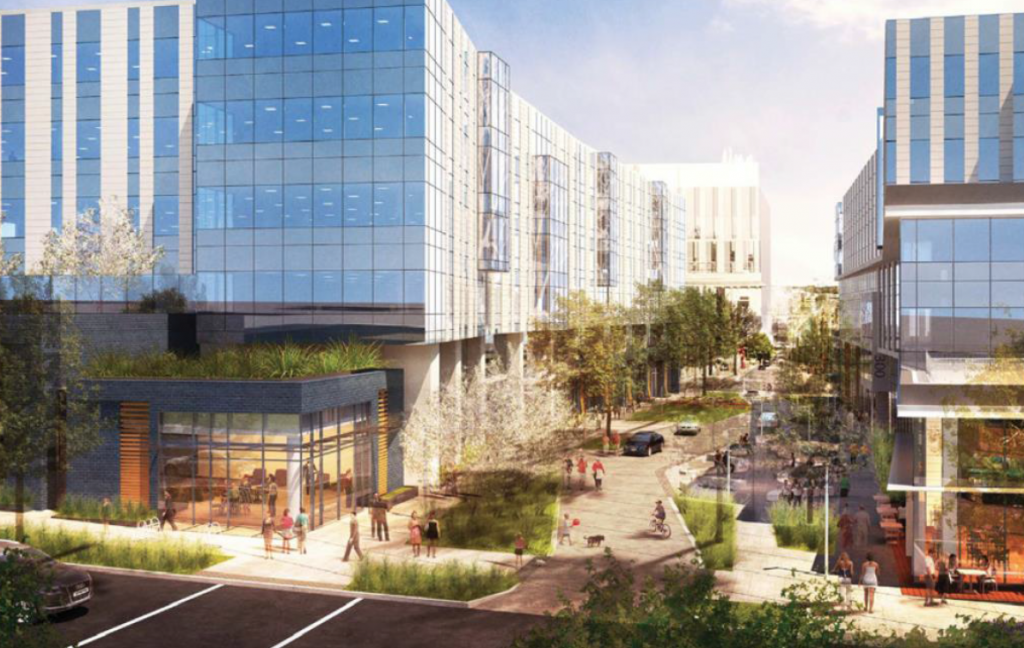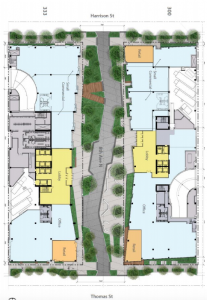
Woonerfs are designed to be living streets, giving space for pedestrians and bicyclists along slower moving cars. They feature traffic-calming measures such as curbless, non-linear streets, extra-wide sidewalks, wood decking with tables and chairs, interspersed pockets of parking, expanded permeable landscaping, pedestrian lighting, and ample seating. They are meant to create “side rooms” in the streetscape, which foster pockets of activity for pedestrians.
The project is part of the voluntary Street Concept Plan—a design vision for the southwest corner of South Lake Union to be a residential zone with premium pedestrian amenities. As part of this plan, the area was rezoned to be almost exclusively residential. However, Vulcan was able to submit it’s plan before the new zoning took effect, vesting their rights to build two six-story corporate offices in the middle of the of the area.
The woonerf proposal sparked a heated debate between Councilmembers Tom Rasmussen and Mike O’Brien, which continued into Tuesdays meeting. At one point, Rasmussen accused O’Brien of being spiteful, while O’Brien shot back the development felt like a “corporate take-over of a public right of way.” Both offer a differing urban vision, revealing the way traditional progressive ideologies can breakdown on the hyper-local level. Below is an overview of each councilmembers’ position and the result of the vote, along with my own suggestions for improvement.
Tom Rasmussen’s Argument
The woonerf would be a welcome addition to the neighborhood, in line with the Street Concept Plan and benefiting the residents surrounding the new Vulcan development. Current plans call for an additional 2055 residential units in the two blocks immediately surrounding the project, ensuring that the residential vision of the neighborhood has not been compromised.
Vulcan’s vision for the woonerf is voluntary, and goes above and beyond the visionary standards for the neighborhood. By fronting the $2.1 million cost, the agreement would save the City $1.5 million if the City were to construct it itself.
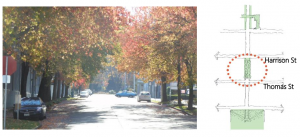
If the agreement were to fall through, a standard street section would be built in its place with a linear road and standard landscaping, missing an opportunity to make the street a destination. The City would also forego drainage improvements that are especially important for the wet neighborhood.
Most of all, the neighborhood wants it. Both the South Lake Union Community Council and the head of a Cascade neighborhood group expressed their deep support for the project. “The community,” he notes, “has said that the woonerf is their preferred design. It meets their vision and their goals for that residential neighborhood.”
The choice on the table is woonerf or no woonerf. It would be a lost opportunity to abandon the project.
Mike O’Brien’s Argument
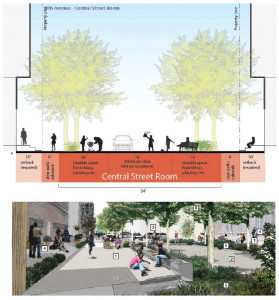
The woonerf is beautiful, true. But as public officials, they have to justify public-private partnerships and the loss of $527,000 in street use fees with strong public benefits. Those don’t seem to exist here.
First, in order to be a public benefit, the project must be accessible to the public. The depictions of this project look like an exclusionary corporate office park. Indeed, many of the key features such as a raised, curbless street, pedestrian furniture, and additional landscaping may act as a visual border to pedestrians, giving the impression of an office courtyard rather than a public space. “It’s a beautiful design,” O’Brien said, “And if I worked at Amazon in this building, I think it would be a great place to use. I question if anyone else is going to use it.”
Second, the project must be a benefit. But it’s not clear how much of an additional public benefit the woonerf would be. The standard street plan still includes wide sidewalks that undulate between six and fifteen feet, large landscaping, and reduced pockets of parking. “Even without these improvements,” he said, “It would still be one of the prettiest streets in the City.”
Third, with nothing to activate the street besides small corner retail, the space will feel dead on evenings and weekends. The original residential vision would not have had this problem, as residential buildings bring activity throughout the day.
Finally, and this appears to be the core of the issue for O’Brien, the development betrays the original vision for the neighborhood. It was supposed to be a purely residential haven to balance out the single-occupant corporate campus, with lively streets lined by porches, stoops, and greenways. The new six-story corporate development popping up in the middle perverts the vision and utility of the pedestrian space—public and pedestrian becomes private and corporate. And that’s not worthy of public subsidy.
Conclusion
In reviewing their arguments, it seems they have both missed critical pieces of the puzzle.
To remedy O’Brien’s concern about the park feeling exclusive to the public, the City should work to expand the woonerf beyond Thomas and Harrison. Expanding it south one block would create a bridge to Denny Park, functioning as a green lifeline into the neighborhood. Though none of the current developments have plans for their own woonerf, the City could fund the project on its own.
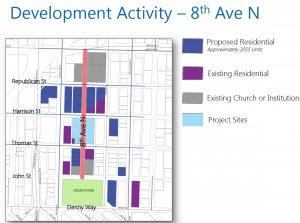
The City could also encourage Vulcan to expand the size of its retail and seek tenants that will engage pedestrians on nights and weekend. Councilmember Godden spoke of her hopes for another brunch spot, envision kids playing on the wide sidewalks as parents waited for a table. Engaging spaces like cafes, piano bars, late-night restaurants, and gyms would activate the space in and around the development, further enriching the neighborhood.
Unexplored by the Council was the option of adding residential development atop the corporate buildings. Perhaps the old zoning laws that apply don’t allow for it. Or Vulcan may have no interest in changing their designs so late in the process. But Vulcan does seem interested in garnering goodwill from the public and Council, and it would bring opportunity for additional profit.
The key to any successful neighborhood is an active streetscape with human-scale development, and that means infrastructure like the woonerf. The new office buildings will be built regardless—one version with a standard-fare street, the other with a bright, engaging, innovative attraction for the 2000 new residents nearby.
Ultimately the vote came down two-to-one for the woonerf, with Godden and Rasmussen joining to support the project. The measure now moves on to the full City Council for consideration, where O’Brien will likely try to garner support from the other six members, most likely finding a friendly ear with Nick Licata and Kshama Sawant.

Ben Crowther
Ben is a Seattle area native, living with his husband downtown since 2013. He started in queer grassroots organizing in 2009 and quickly developed a love for all things political and wonky. When he’s not reading news articles, he can be found excitedly pointing out new buses or prime plots for redevelopment to his uninterested friends who really just want to get to dinner. Ben served as The Urbanist's Policy and Legislative Affairs Director from 2015 to 2018 and primarily writes about political issues.


